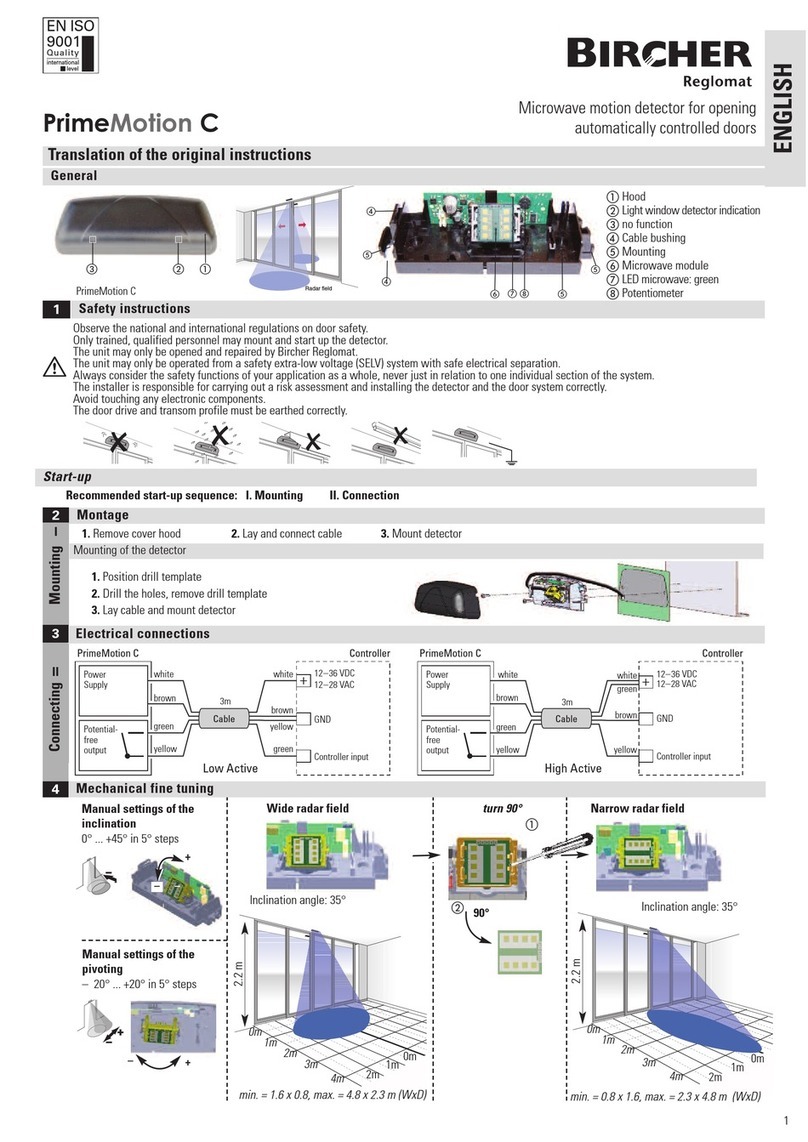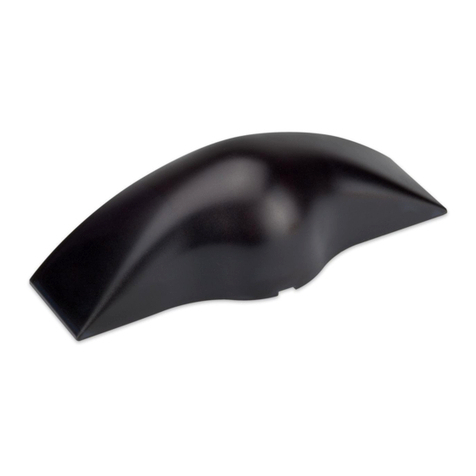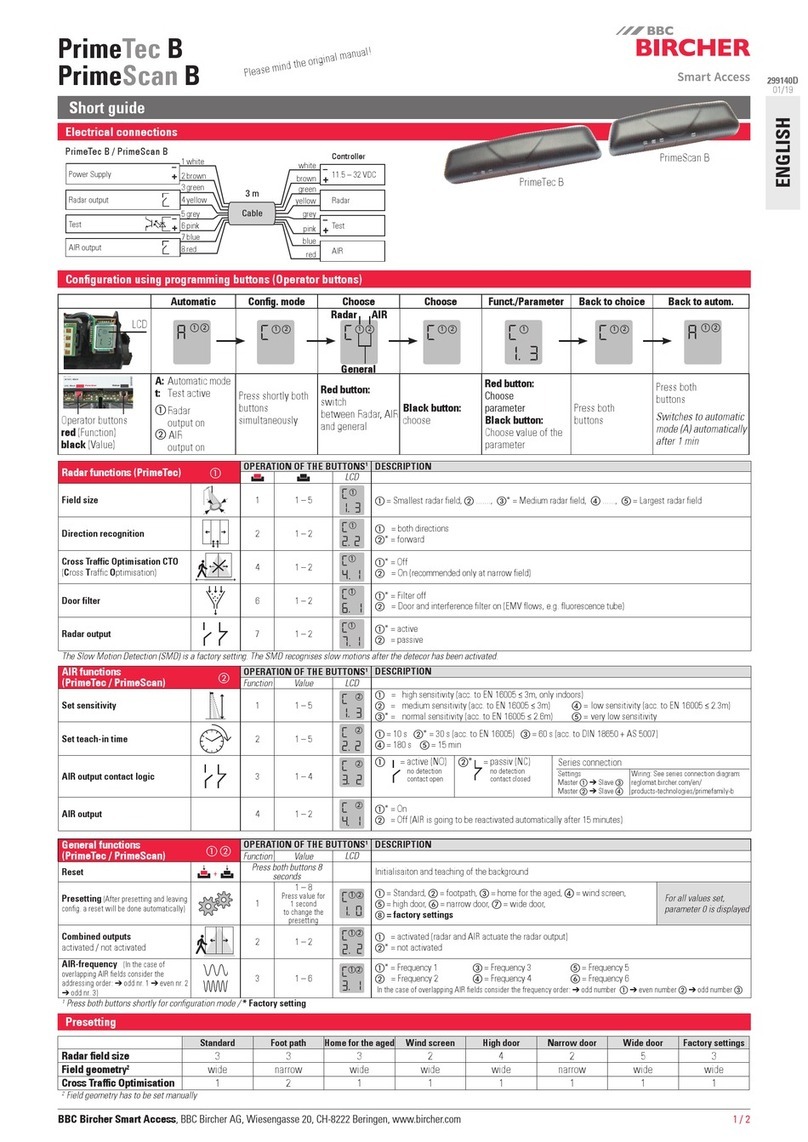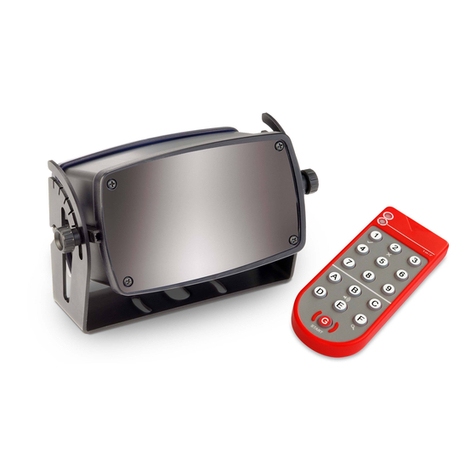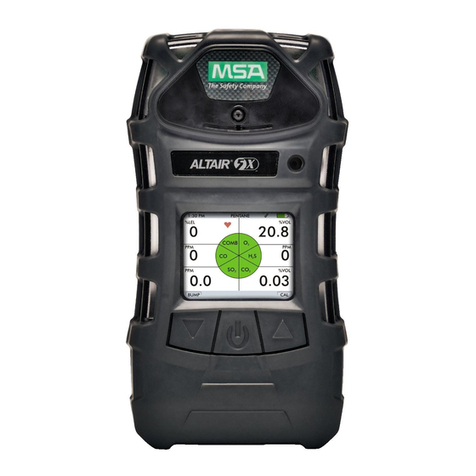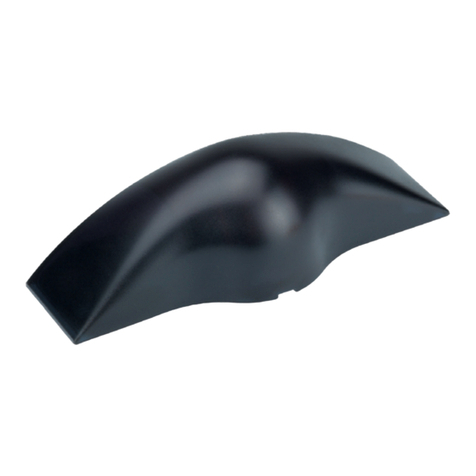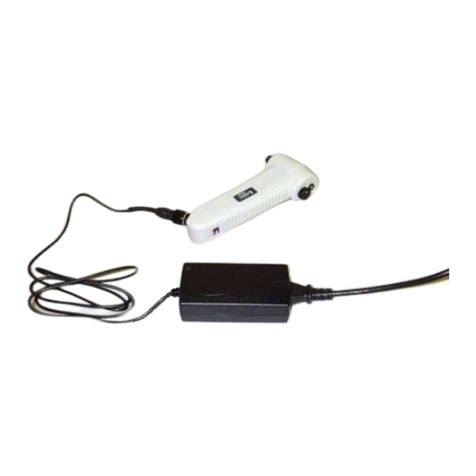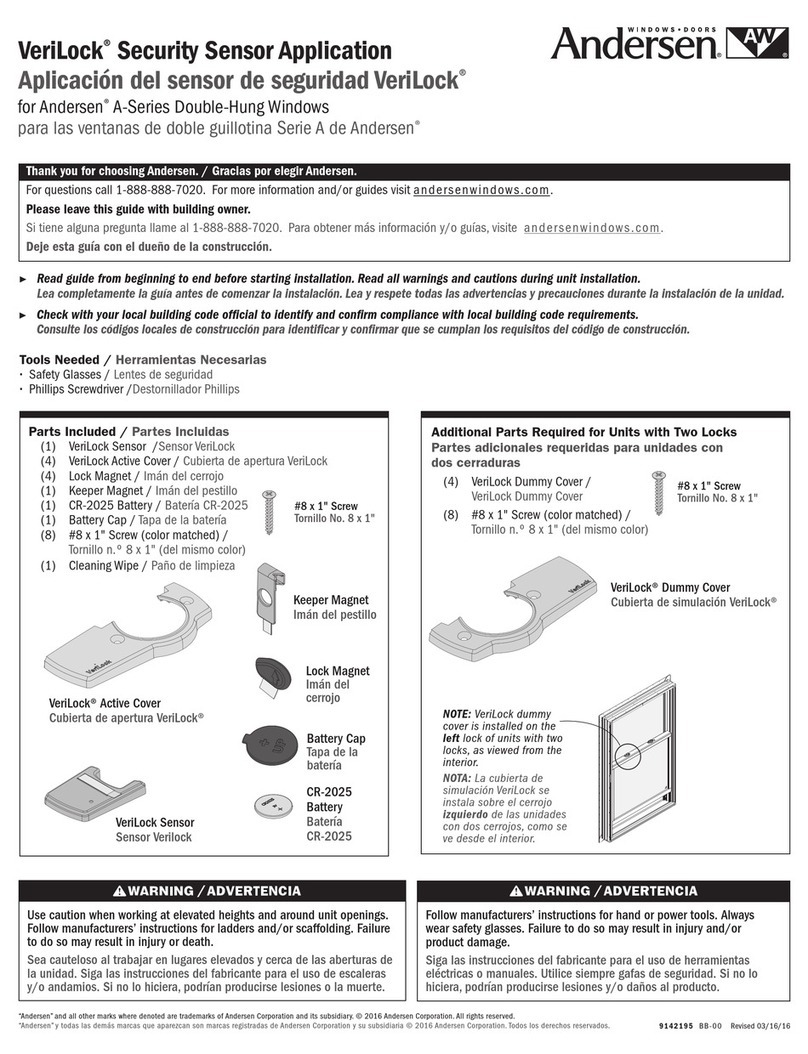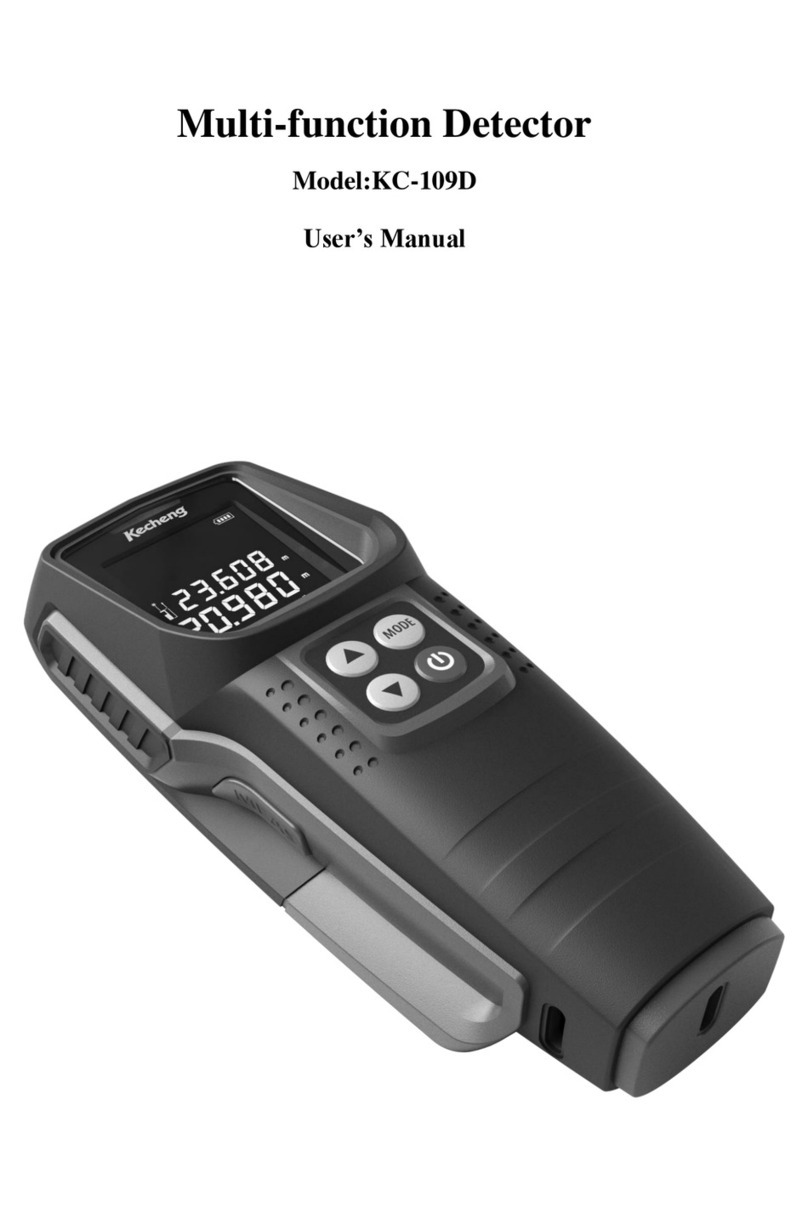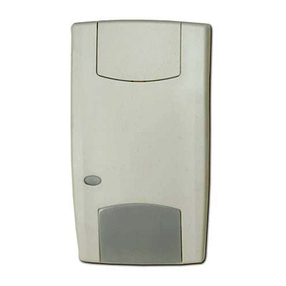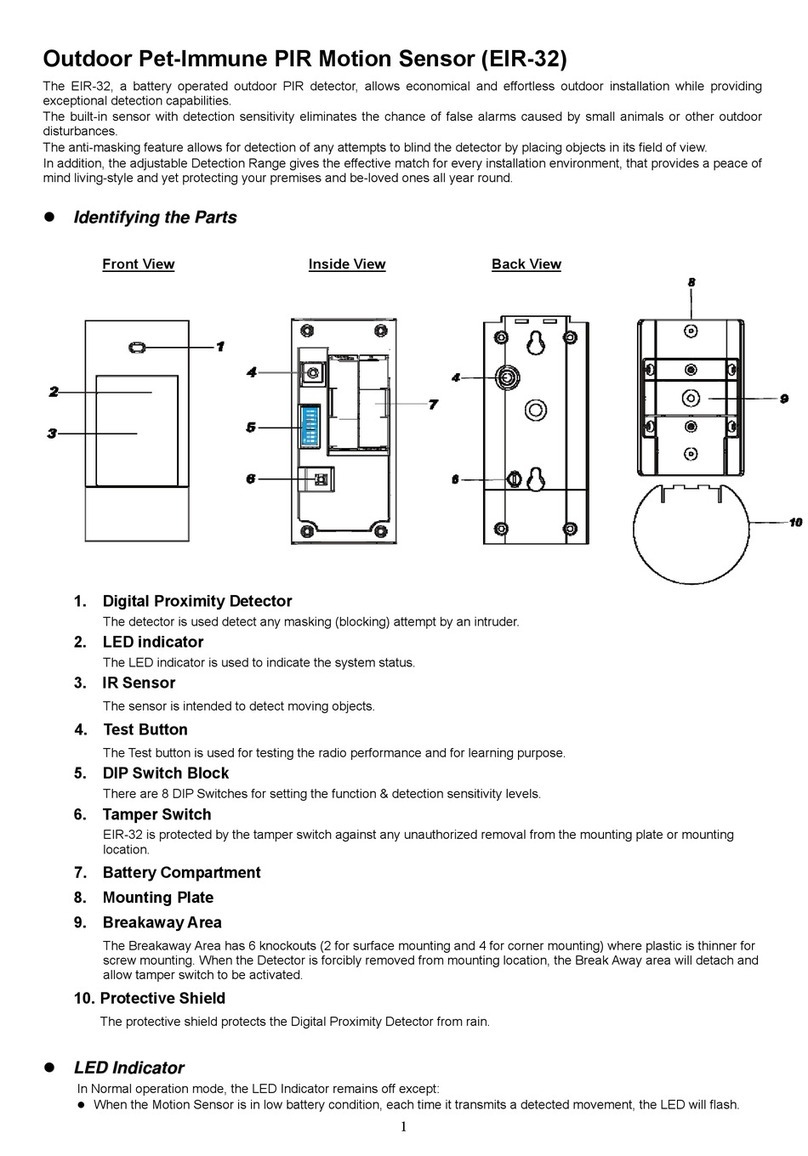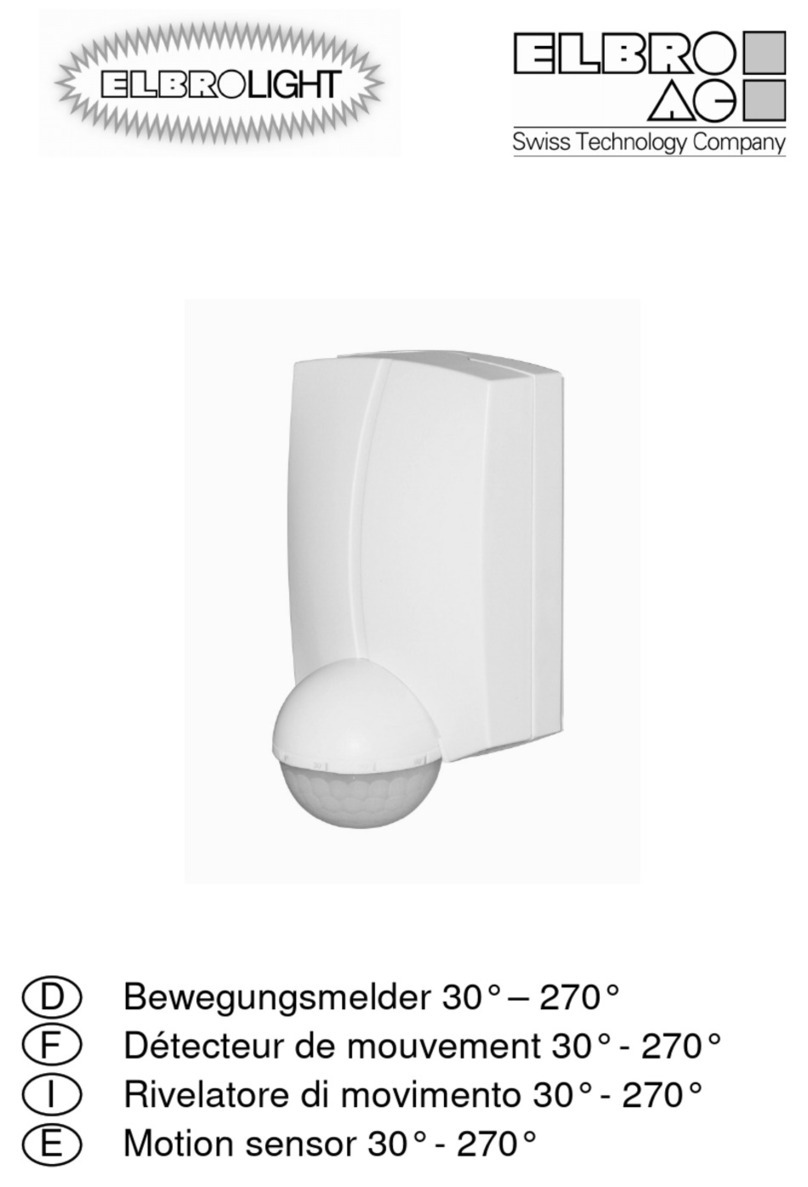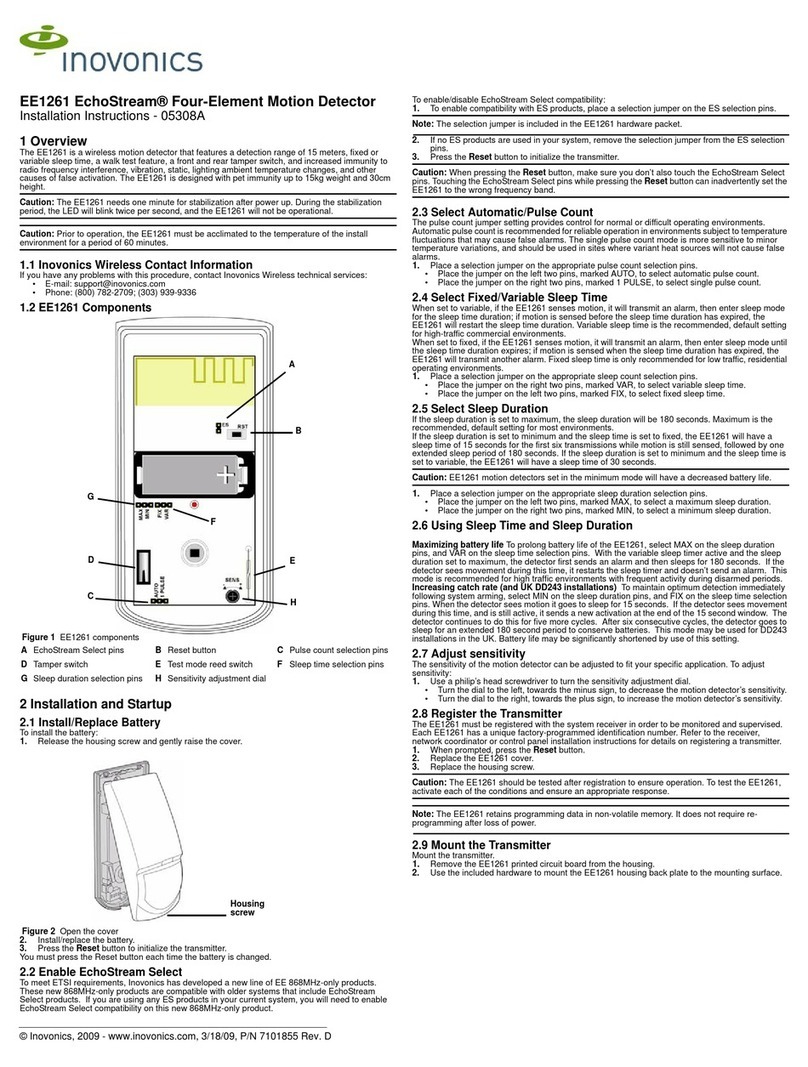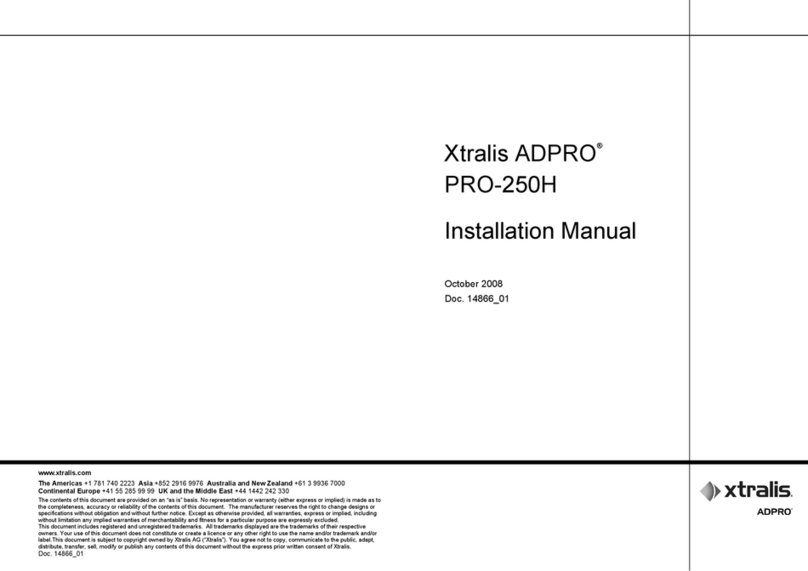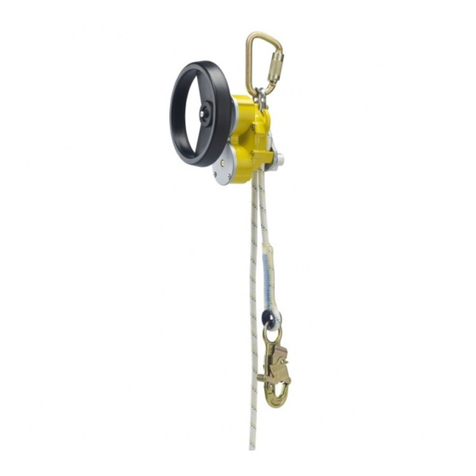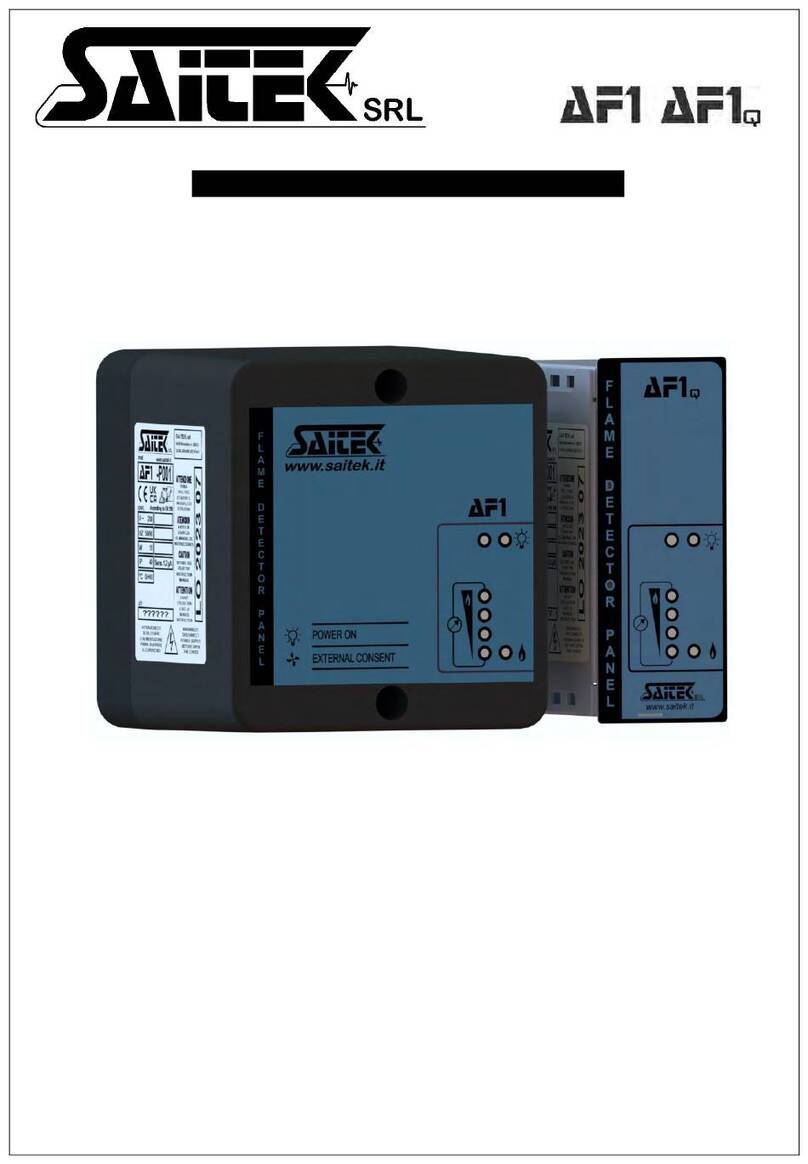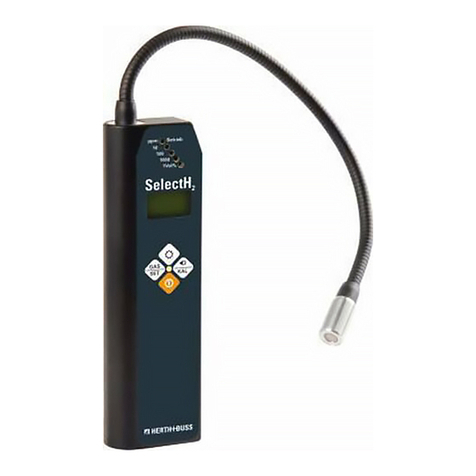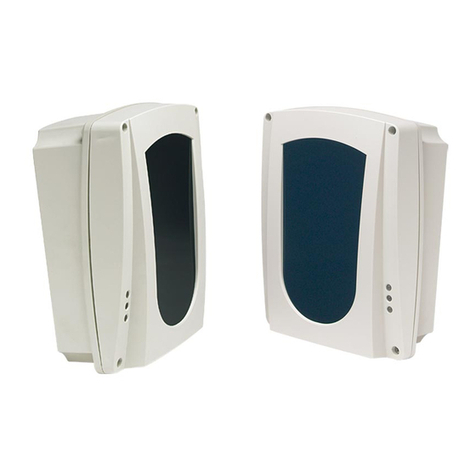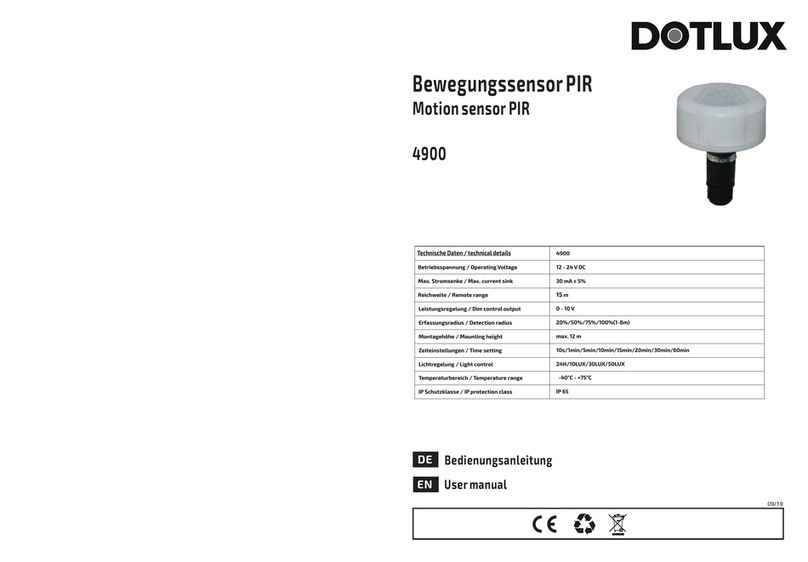Bircher TopScan G3 User manual

TopScanG3 Pr senzmelder für automatisch
angetriebene Tür-Systeme
1Sicherheitshinweise
Das Gerät darf nur an Schutzkleinspannung mit sicherer elektrischer
Trennung betrieben werden. Lassen Sie Eingriffe und Reparaturen nur
durch hren Lieferanten vornehmen. Vermeiden Sie generell
Berührungen mit elektronischen und optischen Bauteilen des Sensors.
Den Sensor gegen Regen schützen und nicht in der Nähe von
Fluoreszenzlampen montieren.
2Inbetriebnahme
Aluminium-Gehäuse (Profil)
Sensor (A R 16 re)
Enddeckel 2x
Frontabdeckung
Lagerböcke 2x
Kreuzschlitzschrauben 2x
(optional)
6
5
4
3
2
1
Originalbetriebsanleitung
Je nach Anwendung, den Detektionsbereich links oder rechts positionieren.
Auf der Rückseite der Senderlinse
die Strahlrichtung entsprechend
einstellen. Dazu den Sender in
Position Loder Rschieben.
Position des Detektionsbereiches
L= Links
R= Rechts
Vorderseite
Schalter 1 Schalter 2
Rückseite
2.2 Detektionsbereich auswählen
2.1 Montage des Aluminiumprofils
Das Aluminium-Gehäuse an der Tür anbringen.
Betriebsart mitfahrend oder nicht mitfahrend
mitfahrender Betrieb: Schalter 1 oben
– kein Hintergrund notwendig, Boden wird ignoriert (Hintergrundausblendung)
– der Sensor ist in dieser Betriebsart nicht testbar (TesteingangTE ohne Funktion)
nicht mitfahrender Betrieb: Schalter 1 unten
– ein stabiler Hintergrund ist zwingend notwendig, der Boden wird
ausgewertet (Hintergrundauswertung)
– der Sensor ist über den Testeingang (TE) testbar
Schaltungsart aktiv/passiv umschaltbar
passiv schaltend: Schalter 2 oben
– bei Spannungsabfall fällt das Relais ab, NC = Anschluss 5 (NO) verwenden
– diese Betriebsart bietet den Vorteil, dass ein Stromausfall oder Kabelbruch als
Detektion interpretiert wird und somit die Türe in den sicheren Zustand bringt
aktiv schaltend: Schalter 2 unten
– NC = Anschluss 4 (NC) verwenden
2.3 Wahl der Schaltungs- und Betriebsart
links rechts
12
12
12
12
Allgemeines
DE EN FR
1
299964E
07/17

Hinweis Testeingang:
Die Testung (TE) ist nur möglich bei:
– nicht mitfahrendem Betrieb
– DC-Speisung
Achtung! Stromlos dargestellt Funktionsweise Testeingang:
Während TE aktiv ist (eine Spannung
anliegt), wird der Sender abgeschaltet.
Dies simuliert eine Detektion und bringt
bei korrekter Funktion das Relais
zum schalten.
Die Tastweite idealerweise
zwischen 250-800 mm über
dem Hintergrund/Boden
einstellen.
Die Tastweite mit dem Einstellrad
justieren.
Kabel gemäss Schema an Klemme
anschliessen
2.4 Elektrischer Anschluss
Steckschraubklemme (1–6) mit
Schraubendreher von unten
herausdrücken.
2.7 Tastweite
Tastweite
vergrössern
Tastweite
vergrössern
Tastweite
verkürzen
2.9 Neigungswinkel
0 bis 30°
2000 mm
1150 mm
Skala
30°
0°
2.8 Detektionsfeld positionieren
Das Detektionsfeld durch schieben
des Sensors positionieren.
Tastweite
verkürzen
2.5 Sensor einsetzen
Bevor die Lagerböcke eingeklickt werden, müssen die Fixierschrauben gelöst sein.
Den Sensor in das Gehäuse einsetzen und die beiden
Lagerböcke zum Sensor schieben.
Hinweis:
Das Kabel hinter dem Lagerbock wegführen.
Darauf achten das die roten Fixierschrauben
ganz gelöst sind bevor der Sensor ins Gehäuse
eingesetzt wird.
2.6 Einstellungen überprüfen
Das Gerät muss mit Spannung versorgt
und betriebsbereit sein.
Den Detektionsbereich mit einem
Stück Papier (A4, matt weiss) oder der
Handfläche überprüfen.
Bei Bedarf die Detektionseigenschaften
gemäss Kapitel 2.7, 2.8 und 2.9 anpas-
sen.
Hinweis:
Bei Detektion leuchtet die LED.
2
3
4
5
6
+⁄~
common
nc
no
Test input
Steckschraubklemme wieder einstecken
und das Kabel über den Führungssteg
wegführen.
Den Neigungswinkel mit Hilfe der
Rasterung am Lagerbock einstellen.
Hinweis:
Unbedingt darauf achten, dass an
beiden Lagerböcken der selbe
Winkel eingestellt ist. Ansonsten
sitzt der Sensor schief im Profil.
800 mm
250 mm
Hintergrund / Boden
Hintergrund / Boden
2

2.10 Sensor fixieren
Nach Abschluss aller Einstellungen, den Sensor durch anziehen
der roten Fixierschrauben befestigen.
Die Betriebsspannung (Klemmen 1+2) und der Relaisausgang (Klemmen
3, 4 und 5) brauchen nur einmal an einem beliebig gewählten Sensor
angeschlossen zu werden.
Hinweis:
Hier kann der Öffner- bzw. Schliesser-Kontakt abgegriffen und zur
Türsteuerung geführt werden. (Klemme 10 und 12)
Eine separate Zuführung einer Speisung für den externen Sensor ist
nicht notwendig.
Über die Flachbandverbindungen können mehrere Sensoren miteinander verbunden werden.
2.11 Gehäuse schliessen
3Erweiterte Anwendungen
3.1 Mehrere Sensoren
12
11
10
9
8
7
+⁄~
–⁄~
Potentialfreier Anschluss
für einen externen Öffner- oder Schliesserkontakt.
Speisung für einen externen Sensor
Die Spannung entspricht der Speisespannung
an Klemme 1 und 2.
Der Anschluss eines externen Sensors geschieht über die Steckschraubklemme 7–12.
3.2 Externe Sensoren
Externer
Sensor
4Beheben von Störungen
Symptom mögliche rsachen Behebung
Türe öffnet zyklisch
oder nur stückweise
Türe öffnet nicht
LED leuchtet nicht
Türe öffnet nicht
LED leuchtet permanent
Türe öffnet
LED leuchtet permanent
Der Sensor detektiert
keine Objekte
Der Sensor detektiert
permanent
nregelmässiges detektieren
ohne Objekt im Detektionsfeld
– bei mitfahrender Anwendung ist der
Sensor auf nicht mitfahrende Betriebsart
konfiguriert
– Tastweite zu nahe am Boden eingestellt
– Schaltungsart (aktiv/passiv)
falsch eingestellt
– Tastweite zu nahe am Boden eingestellt
– Schaltungsart (aktiv/passiv)
falsch eingestellt
– Tastweite zu nahe am Boden eingestellt
– Tastweite zu weit vom Boden entfernt
– Flachbandverbindungen zwischen zwei
Sensoren sind falsch angeschlossen
– starker direkter Regen
– Fluoreszenzlampe in der Nähe
des Sensors
– Spiegelnder intergrund bei gleichzeitig
nahezu senkrecht eingestelltem
Neigungswinkel
– Betriebsart auf mitfahrend ändern
siehe Kapitel 2.3
– Tastweite korrekt einstellen, siehe Kapitel 2.7
– Schaltungsart (aktiv/passiv) ändern
siehe Kapitel 2.3
– Tastweite korrekt einstellen, siehe Kapitel 2.7
– Schaltungsart (aktiv/passiv) ändern
siehe Kapitel 2.3
– Tastweite korrekt einstellen, siehe Kapitel 2.7
– Tastweite korrekt einstellen, siehe Kapitel 2.7
– Sensoren auswechseln
– Sensor auswechseln
– Neigungswinkel verändern, siehe Kapitel 2.9
– Tastweite verändern, siehe Kapitel 2.7
– Fluoreszenzlampe entfernen
– Neigungswinkel vergrössern (siehe
Kapitel 2.9) oder spiegelnden intergrund
entfernen
Befestigen der Endkappen nach Anbringen der Abdeckung. Die Endkappen
mit Führungsstiften auf der Profilseite befestigen. Optional: Zur verstärkten
Befestigung mit Schrauben befestigen. Dazu zuerst die Bohrung freimachen
(durchstossen)
3

1. Die Gewährleistung und aftung der Bircher Reglomat AG richten sich nach dem Kaufvertrag.
2. Die Gewährleistung und aftung erlischt vorzeitig, wenn der Kunde oder Dritte das Produkt nicht gemäss
der vorliegenden Betriebsanleitung einsetzen und/oder bedienen, der Kunde oder Dritte unsachgemässe
Änderungen oder Reparaturen vornehmen, der Kunde oder Dritte, falls ein Mangel aufgetreten ist, nicht
umgehend alle geeigneten Massnahmen zur Schadensminderung treffen und der Bircher Reglomat AG
Gelegenheit geben, den Mangel zu beheben.
3. Von der Gewährleistung und aftung ausgeschlossen sind Schäden, die nicht nachweisbar infolge
schlechten Materials, fehlerhafter Konstruktion oder
mangelhafter Ausführung entstanden sind sowie
Schäden, die aus anderen Gründen entstanden sind, welche die Bircher Reglomat AG nicht zu ver-
treten hat.
4. Eine aftung für Folgeschäden ist ausgeschlossen, soweit zwingende produktehaftpflichtrechtliche
Bestimmungen dem nicht entgegenstehen.
5. Die Gewährleistungsansprüche aus dem Kaufvertrag gegenüber dem ändler werden durch diese
Bestimmungen nicht berührt.
6. Bircher Reglomat AG entwickelt ihre Produkte zum Nutzen ihrer Kunden stetig weiter. Bircher Reglo-
mat AG behält sich das Recht vor, ohne vorherige Ankündigung, an jedem in dieser Dokumentation
erwähnten Produkt, Änderungen vorzunehmen.
5
6
Technische Daten
Detektionsbereich
Tastweiteneinstellung
Temperaturabhängigkeit
Schwarz/Weiss-Differenz
Detektionsfeld
Lichtart
Betriebsspannung
Stromaufnahme
Signalausgang
Ansprechzeit bei Detektion
Abfallzeit nach Detektion
Ansprechzeit bei Testsignal
Testeingang
Betriebsart
Funktionsanzeige
Anschlussart
Schutzart
Gehäusematerial
Frontabdeckung
Optikabstand
Betriebstemperatur
Lagertemperatur
Gewicht
Sensorabmessungen
Gehäusefarbe
100–2500 mm
500–2500 mm
mech. Einstellrad 1500–2500 mm
+60°C: +10%
–20°C: –10%
max. 20%
weiss: grössere Tastweite
schwarz: kürzere Tastweite
ca. 75 mm Durchmesser
IRED
17–30 V DC/18–28 V AC
<110 mA
Relais, Umschaltkontakt
max. Schaltspannung 48VAC/DC
max. Schaltstrom 0.5A AC/1ADC
max. Schaltleistung 55VA/24W
ca. 30 ms
max. 150 ms
max. 2 s
max. 500 ms
mit +UB = 17–30V DC
mitfahrend / nicht mitfahrend
LED rot
Steckschraubklemme
geeignet für den Einsatz gemäss IP52
Aluminium/ABS
PC (schwarz)
150 mm
–20°C bis +60°C
–40°C bis +80°C
45 g
198.5 x 31 x 20 mm
Silber, Schwarz oder Weiss
bei nicht mitfahrendem Betrieb
bei mitfahrendem Betrieb
Triangulationsprinzip
Abweichung gegenüber 20°C
in Bezug auf die eingestellte Tastweite
Unterschied von schwarz zu weiss
in Bezug auf die eingestellte Tastweite
bei Tastweite 2000 mm
gepulstes Wechsellicht 880 nm
galvanisch getrennt
Nennstrom (ohmsche Last) 1A/24VDC
bei ind./kap. Last, Funkenlöschung vorsehen
ohmsche Last
bei nicht mitfahrendem Betrieb
bei mitfahrendem Betrieb
nur bei DC-Betrieb möglich
nur bei nicht mitfahrendem Betrieb
umschaltbar
leuchtet bei erkanntem Objekt
6 x 0.25 mm2
Sender/Empfänger
ohne Gehäuse
Länge/Breite/ öhe ohne Gehäuse
je nach Ausführung
Gewährleistung und Haftung
EG-Konformitätserklärung
Ihr Ansprechpartner / Danish seller
Bircher Reglomat AG
Wiesengasse 20
C -8222 Beringen
www.bircher-reglomat.com
4
ersteller: Bircher Reglomat AG, Wiesengasse 20, C -8222 Beringen
Es wurden folgende Richtlinien eingehalten: Ro S 2011/65/EU, EMC 2014/30/EU, EMC base directive 72/245/EEC,
EMC amendment directive 2004/104/EC, EMC amendment directive 2009/19/EC, ECE-R10 Rev. 03
Produktvarianten: TopScan
Swissdoor ApS
Stenhuggervej 2
DK-5471 Soendersoe
Tlf.: +45 86 28 00 00
www.swissdoor.dk

TopScanG3 Presence detector for
automatic pedestrian swing doors
1Safety instructions
The unit may only be operated from a protection low-voltage system
with electrical separation. The unit may only be opened and repaired
by your supplier! Never touch any electronic or optical components
of the sensor.
Protect the sensor against rain and do not install it in the vicinity of
fluorescent lamps.
2Start-up
General
Aluminium housing (profile)
Sensor (A R 16 re)
End cap 2 x
Front cover
Mounting brackets 2 x
Phillips head screws 2 x
(optional)
6
5
4
3
2
1
Translation of the original instructions
Depending on the door handing, the detection area has to be choosen
(right/left). Standard setting is on the right side.
Set the beam direction on the back
side of the sensor. To do so, slide the
transmitter to position Lor R.
Position of the detection area
L= Left
R= Right
Front
Switch 1 Switch 2
Back
2.2 Selecting the detection area
2.1 Mounting the aluminium profile
Mount the aluminium housing on the swing door.
Operating mode moving or stationary
Moving mode: Switch 1 up
– no background necessary, floor is ignored (background suppression)
– the sensor cannot be tested in this operating mode (test input T without
function)
Stationary mode: Switch 1 down (not recommended on a moving door)
– a stable background is essential, the floor is analysed (background evaluation)
– the sensor can be tested via the test input
Switching mode active/passive variable
Passive variable: Switch 2 up
– The relay de-energises at a fall of voltage, NC = Use connection 5 (NO)
– this setting has the advantage that a power failure or wire damage is inter-
preted as a detection and will trigger the respective safety feature of the door
Active switching: Switch 2 down
– NC = Use connection 4 (NC)
2.3 Selecting the switching and operating modes
left right
12
12
12
12
5
DE EN FR
299964E
07/17

Note on test input:
Testing is only possible for:
– stationary mode
– DC supply Power
Attention: diagrammed currentless! Function of test input:
When the test input is active (voltage
present), the sensor is switched off.
This simulates a detection and when
functioning correctly causes the
relay to switch.
Set the scanning range between
250 mm (9.84") and 800 mm (31.5")
above the background / floor.
Adjust the scanning range with
the adjustment wheel.
Connect the cables to the terminal
in acc. with the diagram
2.4 Electrical connection
The terminal block can be pushed out from
below with a screwdriver if necessary
2.7 Scanning range
ncreasing the
scanning range
ncreasing the
scanning range
Decreasing the
scanning range
2.9 Inclination angle
0 to 30°
2000 mm (6.56')
1150 mm (3.77')
Scale
30°
0°
2.8 Adjust detection area
Adjust the detection area by
sliding the sensor (red mounting
brackets should be open for
easy adjustements).
Decreasing the
scanning range
2.5 Mounting the sensor
Before the mounting brackets are clicked-in the red screw must be released.
Mount the sensor in the housing and slide both mounting
brackets up to the sensor.
Note:
The cable behind the mounting bracket.
Make sure the red screws on the mounting
brackets are fully open before inserting the
sensor into the brackets.
2.6 Checking the settings
Power on the sensor after all installa-
tions have been completed
Check the detection range with a piece
of paper (A4 or Letter 8.5" x 11") or the
palm of your hand.
f necessary, adapt the detection char-
acteristics as described in chapter 2.7,
2.8 and 2.9.
Note: The LED lights up when the
sensor detects a presence.
2
3
4
5
6
+⁄~
commun
nc
no
Entrée de test
Plug the plug-in screw terminal back
in again and route the cable away
over the guide bridge.
Set the inclination angle with the aid of the
detents on the mounting bracket.
Note:
Take care, to have the same angle
adjusted on both side (readable on
the scale). Otherwise the sensor
sits inclined in the profile.
Background / Floor
Background / Floor
800 mm
250 mm
6

2.10 Fixing the sensor
When all the settings are done, secure the sensor by tightening
the red screws on the mounting brackets.
The operating voltage (terminals 1+2) and the relay output
(terminals 3, 4 and 5) need only be connected once to any sensor.
Note:
The NC or NO (Terminal 10 and 12) contact can be selected and led
to the door control.
t is not necessary to provide a separate power supply for the
external sensor (verify transformer capacity to support devices).
Several sensors can be connected to one another using the flat-ribbon connections.
2.11 Closing the housing
3Extended applications
3.1 More than one sensor
12
11
10
9
8
7
+⁄~
–⁄~
Potential-free connection
for an external NC or NO contact.
Power for an external sensor
The voltage corresponds to the supply voltage
at terminal 1 and 2.
An external sensor is connected via the plug-in screw terminal 7–12.
3.2 External sensors
External
sensor
4Troubleshooting
Problem Possible causes Corrective actions
Doors only open
cyclically or partially
Doors do not open
LED does not light up
Doors do not open
LED is permanently lit
Door opens
LED is permanently lit
The sensor detects
no objects
The sensor detects
permanently
Irregular detection without an object
in the detection field
– In the moving application, the
sensor is configured for
stationary mode
– Scanning range set too close to the ground
– Switching type (active/passive) set incorrect-
ly
– Scanning range set too close to the ground
– Switching type (active/passive) set incor-
rectly
– Scanning range set too close to the ground
– Scanning range set too far from the ground
– Flat-ribbon connections between two sen-
sors are connected incorrectly
– eavy direct rain
– Fluorescent lamp in the vicinity of
the sensor
– Reflecting background and at the
same time almost vertically set
inclination angle
– Change the operating mode to moving, see
chapter 2.3
–
Set the scanning range correctly, see chap. 2.7
– Change switching type (active/passive), see
chapter 2.3
–
Set the scanning range correctly, see chap. 2.7
– Change switching type (active/passive), see
chapter 2.3
–
Set the scanning range correctly, see chap. 2.7
–
Set the scanning range correctly, see chap. 2.7
– Replace sensors
– Replace sensor
– Change inclination angle, see chapter 2.9
– Change scanning range, see chapter 2.7
– Remove fluorescent lamp
– Increase inclination angle
(see chapter 2.9) or remove reflecting
background
Affix the end caps after attaching the cover. Affix the end caps with
alignment pins on the profile side. Optional: Affix the end caps with screws
for reinforced fixation. Therefore pierce through the drill-hole.
7

1. The warranty and liability of Bircher Reglomat AG are based on the sales contract.
2. The warranty and liability shall expire prematurely, should the client or third parties not use and/or
operate the product in compliance with existing operating instructions, should incorrect changes or
repairs be made by the client or third parties, should the client or third parties, when a fault has occurred,
not take suitable steps at once for a reduction of possible damage/losses and offer Bircher Reglomat AG
a chance for remedying the said fault.
3. The warranty and liability shall exclude any damage for which there is no proof that it is due to poor
materials, faulty construction, poor workmanship, and any damage caused by other reasons, for which
Bircher Reglomat AG cannot be held liable.
4. No liability can be assumed for any consequential damage, provided this is not governed otherwise
by applicable product liability laws and regulations.
5. Warranty claims made against the seller on the basis of the sales agreement are not affected by these
regulations.
6. For the benefit of its customers Bircher Reglomat AG constantly develops its products further.
Bircher Reglomat AG reserves the right to make changes to any of the products described in this
document without prior notice.
5Technical data
Detection area
Scanning range setting
Temperature dependence
Black/White difference
Detection area
Type of light
Operating voltage
Current consumption
Signal output
Response time on detection
Drop-out time after detection
Response time with test signal
Test input
Operating mode
Function indication
Connection type
Protection class
Housing material
Front cover
Distance between optical units
Operating temperature
Storage temperature
Weight
Sensor dimensions
Housing colour
100–2500 mm (3.94"–98.4")
500–2500 mm (19.7"– 98.4")
Mech.adjustment wheel 1500–2500 mm (59.1"– 98.4")
+60°C (+140°F): +10%
–20°C (–4 ° F): –10%
max. 20%
White: Larger scanning range
Black: Smaller scanning range
Approx. 75 mm (2.95") diameter
IRED
17–30 V DC/18–28 V AC
<110 mA
Relay, changeover contact
Max. switching voltage 48V AC/DC
Max. switching current 0.5A AC/DC
Max. switching capacity 55VA/24W
Approx. 30 ms
Max. 150 ms
Max. 2 s
Max. 500 ms
With +UB = 17–30V DC
Moving / stationary
Red LED
Plug-in screw terminal
Suitable for use in acc. with IP52
Aluminium/ABS
PC (black)
150 mm (5.91")
–20°C to +60°C (–4° F to +140°F)
–40°C to +80°C (–40°F to +176°F)
45 g (1.59 oz.)
198.5 x 31 x 20 mm (7.8" x 1.2" x 0.78")
Silver, black or white
For stationary mode
For moving mode
Triangulation principle
Deviation from 20°C (68° F)
with reference to the scanning range set
Difference between black and white
with reference to the scanning range set
For a scanning range of 2000 mm (78.74")
Pulsed alternating light 880 nm
electrically isolated
Nominal current (ohmic load) 1A/ 24V DC
For ind./ cap. load, provide spark quenching
Ohmic load
For stationary mode
For moving mode
Only possible for DC operation
Only for stationary mode
Can be switched over
Lights up when an object is detected
6 x 0.25 mm2(AWG 23)
Transmitter/receiver
Without housing
Length / Width / eight without housing
Depending on version
Warranty and Liability
Your contact / Danish seller
Bircher Reglomat AG
Wiesengasse 20
C -8222 Beringen
www.bircher-reglomat.com
8
6EC Declaration of conformity
Manufacturer: Bircher Reglomat AG, Wiesengasse 20, C -8222 Beringen
Following directives have been observed: Ro S 2011/65/EU, EMC 2014/30/EU, EMC base directive 72/245/EEC,
EMC amendment directive 2004/104/EC, EMC amendment directive 2009/19/EC, ECE-R10 Rev. 03
Product variant: TopScan
Swissdoor ApS
Stenhuggervej 2
DK-5471 Soendersoe
Tlf.: +45 86 28 00 00
www.swissdoor.dk

TopScanG3 Détecteur de présence pour systèmes
de portes à commandes automatiques
1Consignes de sécurité
L’appareil ne doit fonctionner que sur basse tension de protection avec
coupure électrique sûre. Adressez-vous exclusivement à votre fournis-
seur pour toute intervention ou réparation. En règle générale, évitez tout
contact avec les composants électroniques et optiques du détecteur.
Protéger le détecteur de la pluie et ne pas le monter à proximité de
lampes fluorescentes.
Généralités
Boîtier en aluminium (profilé)
Détecteur (A R 16 re)
Flasque d’extrémité (2 unités)
Capot frontal
Paliers (2 unités)
Vis à tête phillips (2 unités)
(optionnel)
6
5
4
3
2
1
Traduction de la notice originale
En fonction de l’application, positionner le champ de détection à gauche
ou à droite.
Régler la direction du faisceau en
conséquence au dos de la lentille
émettrice. A cet effet, pousser
l’émetteur vers la position Lou R.
Position du champ de détection
L= à gauche
R= à droite
Avant
interrupteur 1 interrupteur 2
Arrière
2.2 Sélection du champ de détection
2.1 Montage profilé en aluminium
Monter le boîtier en aluminium sur la porte.
Mode de fonctionnement mobile ou fixe
fonctionnement mobile: interrupteur 1 en haut
– aucun arrière-plan nécessaire, le sol est ignoré (suppression de l’arrière plan)
– le détecteur ne peut pas être testé dans ce mode d’exploitation (entrée de
test TE sans fonction)
fonctionnement fixe: interrupteur 1 en bas
– un arrière-plan stable est absolument nécessaire, le sol est évalué (évalua-
tion de l’arrière plan)
– le détecteur peut être testé via l’entrée de test (TE)
Type de commutation active /passive
à commutation passive: interrupteur 2 en haut
– Pour qu'en cas de coupure de courant, le contact s'ouvre, utiliser la borne 5 (NO)
– ce mode de fonctionnement présente l’avantage qu’une panne de courant ou
une rupture de câble est interprétée comme une détection et provoque, par
conséquent, la mise sous sécurité des portes
à commutation active: interrupteur 2 en bas
– Contact d'ouverture sur la borne 4 (NC)
2.3 Sélection du type de commutation et mode de fonctionnement
gauche droite
12
12
12
12
2Mise en service
9
DE EN FR
299964E
07/17

Remarque concernant l’entrée
de test:
Le test (TE) ne peut avoir lieu que
dans les cas suivants:
– fonctionnement mode fixe
– alimentation DC
Attention: Contact fermé en cas de
coupure de courant! Principe de fonctionnement de
l’entrée de test:
L’émetteur est désactivé pendant que le
test (TE) est actif (le système est sous
tension). Ceci permet de simuler une
détection et fait commuter le relais en
cas de bon fonctionnement.
Adjuster la distance de détection
dans l'idéal 250-800 mm
au-dessus du arrière-plan / sol.
Ajuster la distance de détection
avec la molette.
Raccorder le câble à la borne
conformément au schéma
2.4 Raccordement électrique
De par le bas, extraire la borne
à vis enfichable (1–6) en la
poussant avec un tournevis.
2.7 Distance de détection
distance de détection
plus longue
distance de
détection
plus longue
distance de détection
plus courte
2.9 Inclinaison
0 à 30°
2000 mm
1150 mm
échelle
30°
0°
2.8 Positionnement du champ de détection
Positionner le champ de détection
en poussant le détecteur.
distance de
détection
plus courte
2.5 Mise en place du détecteur
Avant que les fixations soient positionnées, les molettes rouges doivent
être dégagées. nsérer le détecteur dans le boîtier et
pousser les deux étriers en direction du détecteur.
Remarque:
Loger le câble derrière l’étrier. Vérifiez que la vis
rouge est entièrement dévissés avant d'insérer
le détecteur dans le support de fixation.
2.6 Contrôle des réglages
L’appareil doit être alimenté en tension
et prêt à fonctionner.
Contrôler le champ de détection avec
un morceau de papier (A4, blanc mat)
ou en passant la main.
Au besoin, adapter les paramètres
de détection conformément aux chapit-
res 2.7, 2.8 et 2.9.
Remarque:
La LED est allumée en cas de détection.
1
2
3
4
5
6
–⁄~
+⁄~
comune
nc
no
Ingresso Test
Enficher à nouveau la borne à vis et
loger le câble au-dessus de la nervure
de guidage.
Régler l’inclinaison à l’aide du repère
sur l’étrier.
Attention:
Bien ajuster ensemble les
deux côtés dans le même angle
(graduation lisible). Sinon le
détecteur serait dévié dans le
profil.
Arrière-plan / sol
Arrière-plan / sol
800 mm
250 mm
10

2.10 Fixation du détecteur
Les réglages terminés, fixer le détecteur en serrant les vis
rouges.
La tension de service (bornes 1+2) et la sortie du relais (bornes 3, 4 et 5)
ne doivent être raccordées qu’une seule fois à un détecteur quelconque.
Remarque:
C’est ici que le contact de repos et le contact de travail peuvent être
prélevés et acheminés à la commande de la porte (bornes 10 et 12).
l n’est pas nécessaire de prévoir une alimentation distincte pour le
détecteur externe.
Les connecteurs de câbles plats permettent de relier plusieurs détecteurs les uns aux autres.
2.11 Fermeture du boîtier
3Applications étendues
3.1 Plusieurs détecteurs
12
11
10
9
8
7
+⁄~
–⁄~
Connexion sans potentiel
pour un contact de repos ou de travail externe.
Alimentation pour un détecteur externe
La tension correspond à la tension d’alimentation
aux bornes 1 et 2.
La connexion d’un détecteur externe s’effectue au moyen de la borne à vis enfichable 7–12.
3.2 Détecteurs externes
Détecteur
externe
4Elimination des dérangements
Symptôme Causes possibles Remède
La porte s’ouvre de manière cyclique
ou seulement en partie
La porte ne s’ouvre pas
La LED est allumée en permanence
La porte ne s’ouvre pas
La LED est allumée en permanence
La porte s’ouvre
La LED est allumée en permanence
Le détecteur ne détecte
pas d’objets
Le détecteur détecte des objets
en permanence
Détection irrégulière sans objet dans
le champ de détection
– En mode mobile, le détecteur est
configuré pour une exploitation non mobile
– La distance de détection réglée est trop pro-
che du sol
– Type de commutation (active / passive)
mal réglé
– La distance de détection réglée est trop pro-
che du sol
– Type de commutation (active / passive)
mal réglé
– La dist.de détect. réglée est trop proche du sol
– La dist. détect. réglée est trop éloignée du sol
– Les connecteurs de câbles plats reliant deux
détecteurs sont mal raccordés
– Forte pluie directe
– Lampe fluorescente à proximité
du détecteur
– Arrière-plan réfléchissant en combinaison
avec un angle d’inclinaison quasiment
vertical
– Régler le mode de fonctionnement sur mobi-
le, voir chapitre 2.3
– Régler correctement la distance de
détection, voir chapitre 2.7
– Modifier le type de commutation
(active/passive), voir chapitre 2.3
– Régler correctement la distance de détecti-
on, voir chapitre 2.7
– Modifier le type de commutation
(active/passive), voir chapitre 2.3
– Régler correctem. la dist. de détect.,chap. 2.7
– Régler correctem. la dist. de détect.,chap. 2.7
– Remplacer les détecteurs
– Remplacer le détecteur
– Modifier l’angle d’inclinaison, chap. 2.9
– Modifier la distance de détection, chap. 2.7
– Retirer la lampe fluorescente
– Agrandir l’angle d’inclinaison
(voir chapitre 2.9) ou retirer l’arrière-plan
réfléchissant
Fixation des flasques d’extrémité après fixation du capot frontal.
Fixer les flasques d'extrémité avec les axes de guidage.
Optionnel: Fixation avec vis à têtes phillips pour renforcement.
11

1. La garantie et la responsabilité de Bircher Reglomat AG sont définies dans le contrat de vente.
2. La garantie et la responsabilité expirent avant le délai fixé lorsque le client ou des tiers utilisent le produit
et/ou le manipulent sans se conformer aux instructions de service, que le client ou des tiers effectuent des
modifications ou réparations inadéquates ainsi que lorsque le client ou des tiers, ayant constaté un défaut,
ne prennent pas immédiatement toutes les mesures propres à limiter le dommage et permettent à Bircher
Reglomat AG de procéder à la réparation requise.
3. Sont exclus de la garantie et de la responsabilité tous les dommages qui ne sont pas dus, conformément
à des preuves y relatives, à des défauts de matériel, de construction ou d’exécution, de même que les
dommages dus à d’autres causes, indépendantes de la volonté de Bircher Reglomat AG.
4. Sauf disposition contraire de la législation relative à la responsabilité du fait du produit, Bircher Reglo-
mat AG n’assume aucune responsabilité pour les dommages consécutifs.
5. Ces stipulations ne portent pas atteinte aux droits à la garantie résultant du contrat de vente à l’égard du
revendeur.
6. Bircher Reglomat AG développe continuellement ses produits dans l’intérêt de ses clients. Bircher Reglo-
mat AG se réserve le droit d’apporter des modifications, sans notification préalable, à chacun des produits
mentionnés dans cette documentation.
5Données techniques
Champ de détection
Réglage de la distance de détection
Variabilité avec la température
Différence noir/blanc
Champ de détection
Type de lumière
Alimentation
Consommation de courant
Sortie de signal
Temps de réponse en cas de détection
Temps de chute après la détection
Temps de réponse en cas de signal de test
Entrée de test
Mode d’exploitation
Indicateur de fonction
Type de raccordement
Type de protection
Matériau du boîtier
Capot frontal
Distance du système optique
Température de fonctionnement
Température de stockage
Poids
Dimensions du détecteur
Couleur du boîtier
100–2500 mm
500–2500 mm
molette méc. 1500–2500 mm
+60°C: +10%
–20°C: –10%
max. 20%
blanc: distance de détection plus longue
noir: distance de détection plus courte
diamètre d’env. 75 mm
IRED
17–30 V DC/18–28 V AC
<110 mA
Relais, contact de commutation
Tension de commutation max. 48VAC/DC
Courant de commutation max. 0.5A AC/1ADC
Puissance de coupure max. 55VA/24W
env. 30 ms
max. 150 ms
max. 2 s
max. 500 ms
avec +UB = 17–30V DC
mobile /non mobile
LED rouge
Borne à vis enfichable
convient à une utilisation selon IP52
aluminium/ABS
PC (noir)
150 mm
de –20°C à +60°C
de –40°C à +80°C
45 g
198.5 x 31 x 20 mm
Argent, noir ou blanc
en fonctionnement mode mobile
en fonctionnement mode mobile
Principe triangulaire
Ecart par rapport à 20°C en fonction
de la distance de détection réglée
Différence entre noir et blanc
en fonction de la distance de détection réglée
pour une distance de détection de 2000 mm
lumière alternante pulsée de 880 nm
avec isolation galvanique
Courant nominal (charge ohmique) 1A /24V DC
Prév. dispos. pare-étincelle en cas de charge ind./cap.
charge ohmique
en fonctionnement mode fixe
en fonctionnement mode mobile
uniquement possible en DC
uniquement en fonctionnement mode fixe
commutable
allumé en cas de détection d’objet
6 x 0.25 mm2
émetteur/récepteur
sans boîtier
Longueur / largeur / hauteur sans boîtier
selon la version
Garantie et responsabilité
Votre contact / Danish seller
Bircher Reglomat AG
Wiesengasse 20
C -8222 Beringen
www.bircher-reglomat.com
12
6Déclaration CE de conformité
Fabricant: Bircher Reglomat AG, Wiesengasse 20, C -8222 Beringen
Les directives suivantes ont été observées: Ro S 2011/65/EU, EMC 2014/30/EU, EMC base directive 72/245/EEC, EMC amendment directive 2004/104/EC,
EMC amendment directive 2009/19/EC, ECE-R10 Rev. 03
Variantes des produits: TopScan
Swissdoor ApS
Stenhuggervej 2
DK-5471 Soendersoe
Tlf.: +45 86 28 00 00
www.swissdoor.dk
Table of contents
Languages:
Other Bircher Security Sensor manuals
